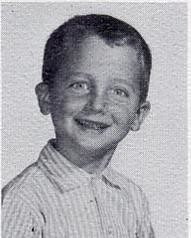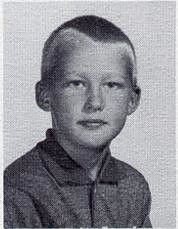(This article replaces an article that was posted on this blog on June 29 and which now has been removed.)
For its recent anniversary celebration, St John school published on its website a table listing all students who have graduated since the school was established in 1885. The table lists the graduation year and name of each such student.
The table does not list students who did not graduate. For example, if a student attended first through seventh grade and then left before completing the eighth grade, he is not listed.
For most years, the graduation year was eighth grade, but from 1973 through 1991 the graduation year was ninth grade. In 1991 both the eighth and ninth grades graduated.
Using the table's information, I have approximated the enrollment size of the first grade and of the entire school (not including kindergarten) for each year. I then averaged those approximations for each five-year period. My results are listed in the table below.
| Period |
1st
Grade |
All
Grades |
| 1885-1889 |
9 |
51 |
| 1890-1894 |
10 |
72 |
| 1895-1899 |
17 |
103 |
| 1900-1904 |
15 |
129 |
| 1905-1909 |
18 |
129 |
| 1910-1914 |
20 |
146 |
| 1915-1919 |
23 |
166 |
| 1920-1924 |
25 |
190 |
| 1925-1929 |
18 |
183 |
| 1930-1934 |
22 |
162 |
| 1935-1939 |
18 |
161 |
| 1940-1944 |
18 |
148 |
| 1945-1949 |
21 |
158 |
| 1950-1954 |
27 |
185 |
| 1955-1959 |
33 |
225 |
| 1960-1964 |
43 |
290 |
| 1965-1969 |
48 |
368 |
| 1970-1974 |
34 |
365 |
| 1975-1979 |
32 |
309 |
| 1980-1984 |
31 |
289 |
| 1985-1989 |
37 |
300 |
| 1990-1994 |
39 |
309 |
| 1995-1999 |
28 |
286 |
| 2000-2004 |
26 |
206 |
| 2005-2009 |
19 |
150 |
For the individual year 1942, I estimated the number of first graders as 15 students and the number of all students (1st through 8th grades) as 142. That year was the low point of the school's enrollment after 1911. The students who entered first grade in 1942 were born in about 1936, which was the depth of the Great Depression. I suppose that relatively few children were born in Seward in the mid and late 1930s, and those children's families suffered from financial difficulties. Also, the Lutheran Church suffered financial difficulties during the years preceeding 1942.
After 1942, enrollment grew steadily as Seward families had more children, as Seward families became more prosperous, as the Lutheran Church became more prosperous, and as Concordia College hired more faculty, who moved into Seward with their children and who had even more children in Seward.
In 1965 and 1966 the school enrolled its largest first-grade classes -- 56 and 57 students respectively. As those two large classes rose through higher grades, the school's total enrollment reached a peak in 1970 -- 377 students. In 1973 the enrollment rose to 381, but that was because a ninth grade was added to the school.
After the early 1970s, enrollment declined steadily, even though the school had nine grades until 1991.
This fall of school enrollment corresponds to the decline of the USA's fertility rate

and to the decline of the number of children per family.

I suppose that another factor peculiar to St John is related to the fact that a large portion of the students are children of faculty members of Concordia College. I think that a lot of young faculty members joined the faculty during the 1960s (for example, my father) as the college grew and prospered, and young faculty members have young children. During the 1970s those now-older faculty members received tenure and fewer young faculty members were hired.
I suppose that yet another factor in the decline of St John's enrollment is that more non-Concordia families in Seward were satisfied to send their children to the public school. I assume that the quality of Seward's public schools have improved steadily. About half of St John's graduating class every year advanced to Seward High School instead of to Concordia High School. As these young people who had attended both St John and Seward High School eventually got married and had their own children, many of these young parents felt more loyalty to Seward's public schools, especially if one of the spouses had not attended St. John.
I suppose also that, even in Seward, the population has become less religious and more secular. The proportion of the population that feels strongly that their children should receive the kind of religious education that St John offers is declining. Many people, even graduates of St John, have come to assume that a religious education is even inferior to a secular education.
Since the year 2001 the cost of tuition certainly has become a major factor in the further decline of enrollment at St John. Ms. Bonnie Katt, who was the secretary for St John school from 1973 to 2005, described the change of tuition to me as follows:
After the ninth grade was established in 1973 we had an enrollment of around 365 most years. After we dropped the ninth grade it was around 335-345. Tuition was added in 2001 and the enrollment dropped considerably for the next several years. I believe the enrollment is around 150 now.
Before 2001, there was an enrollment fee and what we called a capitol-use fee, which was $50 per child per semester. I believe the enrollment fee was around $175 per child per year.
The first year for tuition was the fall semester of 2001, when the first child was $750 and then it was less for the second and third child, and the fourth child was free.
I think the abuse charges were an excuse [for the enrollment decline], as all allegations of abuse were from students in the 1970s. We sent out a survey in the fall of 2002 or 2003 to the parents of students that were pulled, and only one came back as a safety issue.
Also I think family size is also a factor. In the 1970s and 1980s lots of the college profs had five and six children in their families, and in the l990s the Concordia University faculty was older with grown children and also smaller families.
I am also saddened with the enrollment [decline] because St. John is a very good school with wonderful teachers and staff. I thoroughly enjoyed my years at St. John. Both my daughters graduated from St. John and received a fantastic education. Our oldest is a registered nurse with a masters degree in administration and our youngest is an aeronautical engineer. I truly feel that their early education really gave them the solid foundation.
If the enrollment had fallen to 150 already before the current economic crisis began, then St John school certainly is struggling to survive. I hope that the Missouri Synod and Concordia University will keep in mind that St John School has played an important role in helping the Lutheran Church educate teachers and maintain a parochial school system. I think the Synod and the University should recognize the necessity to subsidize St John School financially so that it can raise its enrollment significantly.
I think also that the people of Seward should recognize that St John School plays an important role for the town, because it plays an important role for the University. I hope that more young families in Seward will decide to enroll their children to St John School, even though this commitment has become more expensive. Parents who send their children to St John School and then to Seward High School will give their children a diverse educational experience in both school systems.
I remind those Seward residents who did attend St John as children that they did receive an excellent education there. We learned the Bible, we learned the history of the Protestant Reformation and we learned about the Lutheran Church -- in addition to the all the standard Reading, Riting and 'Rithmetic that we learned well. Give your own children the same education, and you won't regret it.
Method of Estimating Enrollment
St John School posted a table listing its graduates in a pdf file on this webpage.
The students listed for the school's first years are from lists of young people who were confirmed in the church not from particular school records. The confirmation lists probably do not match the actual students of the school exactly. Probably there more young people who were confirmed than there were who attended the school. There are no records for any confirmations in the years 1897 or 1907. Perhaps nobody was confirmed in those years, or perhaps the confirmation records have been lost.
There are 57 names without graduation years at the end of the table. Ms. Katt explained to me that those were former students who left the school before completing eighth grade but who wanted to be listed in the 1984 yearbook. I did not include any of those names in the following analysis.
The table does not include any graduates for the year 1973, because that was the year when the school added a ninth grade. The students who completed eighth grade in 1973 then attended ninth grade in 1974 and are listed as 1974 graduates.
In 1991 the school removed the ninth grade, so in that year both the eighth grade and the ninth grade graduated from St. John. The table distinguishes between the members of those two classes.
I downloaded the pdf file, copied the entire table, and pasted it into a Word file, where I deleted unnecessary elements to simplify the table. I converted the Word document into a text file, which I imported into Microsoft Access to create a database table.
Each graduate was represented in this Person table by a record that included fields for first name, last name and graduation year. (There are also fields for gender and spouses, but those fields are irrelevant to this discussion.) This table was linked to a related table for each year, which was linked to a related table for each five-year period.
A query was run on the Person table to group and count the persons for each year. Those counts were typed into the Year table, and then a query was run on the Year table to group and average the counts for the five-year periods. The result was the average number of students in the graduating class for each five-year period.
To calculate the size of the entire school's enrollment for each year, I totaled the sizes of that year's graduation class and the sizes of the next seven years' graduation classes. For example, for the year 1966, when I graduated from St John school, the table lists only the students in my eighth grade class; the table does not list students in grades one through seven in 1966.
However, I approximated those other class sizes in 1966 by counting the students in the eigth-grade class of 1967 (i.e. seventh grade in 1966), the eighth grade class of 1968 (i.e. the sixth grade class in 1966), and so forth through the eighth-grade class of 1973 (i.e. the first-grade class of 1966). Those numbers are below (graduation year -- number of students in that graduation year -- grade in 1966):
1966 -- 32 -- 8
1967 -- 41 -- 7
1968 -- 42 -- 6
1969 -- 40 -- 5
1970 -- 45 -- 4
1971 -- 49 -- 3
1972 -- 56 -- 2
1973 -- 57 -- 1 (class of 1974)
Total= 362
(In 1973, the school added a ninth grade, so the class that was in the eighth grade in 1973 did not graduate until 1974. Therefore the table does not include a graduation class of 1973, and I have applied the count of 57 students of the 1974 class to the above calculation.)
Class sizes change from year to year, as some students leave a class and other students join a class, so the size of the first-grade class will change by the time that class becomes the eighth-grade class, but the approximation is quite close.
Because a yearbook was published in 1966, we can check the approximation by counting the number of students pictured in the yearbook. Here are those counts (grade -- count):
8 -- 34
7 -- 43
6 -- 43
5 -- 46
4 -- 49
3 -- 48
2 -- 61
1 -- 47
The sum of the numbers in the second column is 371. The approximation from the previous method was 362, which is a discrepancy of 9 students, which is a 2.4% error from 371.
The table listed 32 students in the class that graduated in 1966, but the 1966 yearbook shows 34 students in that eighth grade. A comparison of the table with the yearbook showed the following discrepancies:
Shirley Erks pictured in eighth grade yearbook, but not listed in 1966 in table
Ann Marie Holtz pictured in eighth grade in yearbook, but not listed in 1966 in table
Dick Rolfsmeier pictured in eighth grade in yearbook, but not listed in 1966 in table
Rodney Wood pictured in eighth grade in yearbook, not not listed in 1966 in table
Ricky Lievert listed in 1966 in table, but not not pictured in eighth grade in yearbook
Stephen Voss listed in 1966 in table, but not pictured in eighth grade in yearbook
There are several possible explanations for those discrepancies. Perhaps some of the students in the yearbook failed to complete the year successfully and so were held back to graduate in a following year. For example, Shirley Erks is listed in the class that graduated in 1967. On the other hand, perhaps a couple of the students in the seventh grade skipped eighth grade and advanced directly to ninth grade and so were listed with the 1966 graduating class. I remember that Stephen Voss was a very intelligent student in the class behind me, and I would not be suprised if he skipped eighth grade. (I don't remember Ricky Lievert at all.)
Other possible explanations for discrepancies between the table and the yearbook might be that there are errors in the table and that some students' pictures were not included in the yearbook. In general, I think that my approximation method is accurate to about a 2.4% error rate.
I coded and ran a computer procedure to apply my approximation method to every year in my data base, thus estimating the school's entire enrollment, for all grades, for each year. These counts were typed into the Year table, and an inquiry was run to accumulate the average for each five-year period.
Much difficulty was caused by the fact that the school had nine grades during the years 1973 to 1991. Therefore to the Person table I added a field that stated the year when each student would have entered first grade. That field was filled by subtracting seven from the graduation year of every student who graduated in eighth grade and subtracting eight from the graduation year of every student who graduated in the ninth grade.
I then re-ran all the above procedures using the first-grade year instead of the graduation year. This time, though, the classes of the previous (not subsequent) seven or eight years were added to estimate the school's entire enrollment, because the base was first grade, not the graduation grade. I think that this adjustment did not raise the error rate significantly above 2.4%
The above method of estimating the school's enrollment did not work after 2001, because there were no longer eight sequential graduating-class counts to total. Therefore the available graduation classes were averaged, and that average was used for each of the other classes so that eight numbers were totaled.
In addition, Ms. Katt told me that the enrollment fell to around 150 after the tuition was raised significantly in the year 2001. Therefore I simply used the number 150 as the average for the five-year period that began in 2005. I divided that 150 by eight to calculate the average size of the first grades for that five-year period.
I will provide a copy of my Access database to anyone who requests it.








